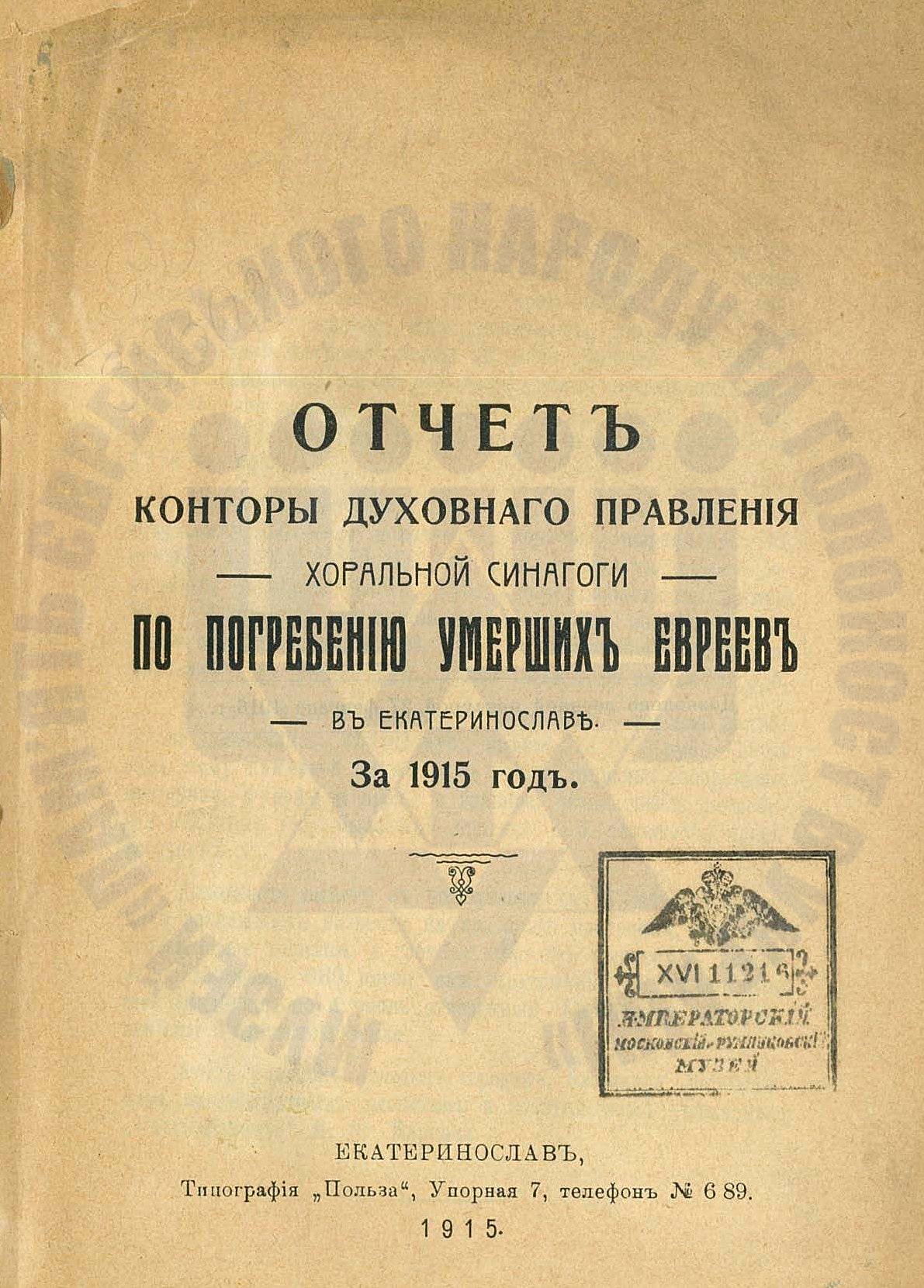A new exhibit Report of the Spiritual Board of the Choral Synagogue on the burial of dead Jews in Katerynoslav in 1915 recently appeared in Museum "Jewish Memory and Holocaust in Ukraine". Despite the accounting and statistical nature of the publication, the brochure is a very informative source on the history of the city and the life of its integral part - the Jewish community.
The text of the Report does not specify its compiler. However, the introduction makes one think of a man not devoid of the ambitions of a writer, but limited by the power of fate within the "non-literary" genre.
«1915 is an exceptional year, a year when everything unusual has become commonplace: War has created new situations, new living conditions, the population has increased dramatically, mortality, of course, has also increased, but epidemics have claimed many lives, and nervousness and influence can be seen. unprecedented world war, had its impact on mortality»[1].
Given the indicators of the latter, as well as the increase in the number of inhabitants of Katerynoslav (including refugees from the northwestern provinces of the Russian Empire)[2], the problem of expanding the territory of urban necropolises, especially those where they found their last earthly shelters of Jewish citizens. At that time, the main burial place for the Jewish community of Katerynoslav was the so-called New Jewish Cemetery. It was located on the southwestern outskirts of the city in the area of the then Nikopol Way (now it is the territory of the park named after Lev Pisarzhevsky, which is between the modern Oleksandra Polya and Bohdana Khmelnytskoho Avenue). The decision to create a necropolis was made in 1900, when the City Council of Katerynoslav allocated 7 acres of land. In the immediate vicinity of the Jewish burials was the area of the Muslim cemetery of the city (its southern part, bordering the Nikopol Way)[3]. Next to them, but on the opposite side of the road, was to be located almost three times larger (20 acres) city cemetery (now the park of the 40th anniversary of the liberation of Dnepropetrovsk, between Bohdan Khmelnytsky Avenue and Zaporizske Highway).
In the first years of its existence, the cemetery was surrounded by a high wooden fence with brick pillars [4]. Despite the war, the Jewish community and its leaders succeeded in 1915 in replacing it with a solid brick fence 660 fathoms long [5]. In the same year, thanks to "many years of repeated efforts and petitions of the esteemed" Rosh Hahavre "M. Karpas", the city transferred another 3 tenths of land for the expansion of the cemetery [6]. Speaking about the contribution of other philanthropists, the report's organizers especially noted Ms. Rosa Levenberg, who donated 6,000 rubles to the Funeral Home. Thanks to these and other donations during the year it was possible not only to fence the cemetery, but also "to build on the cemetery buildings, bridges, asphalt paths" [7].
At that time, there were both individual and group burials in the cemetery. For example, in the eastern part of the cemetery (the part of the L. Pisarzhevsky Park, which is now closer to Gavrilenko Street) was the mass grave of the victims of the anti-Jewish pogrom that swept through Ekaterinoslav on October 21-23, 1905. His victims (killed and wounded) it is estimated that almost three hundred people[8].
The report contains detailed financial information related to the improvement and maintenance of the necropolis, staffing, a list of names and surnames of 671 people [9], who were buried in the cemetery during the reporting year 1915, as well as extremely interesting statistics on the causes of death of Katerynoslav century ago. Thus, among them the largest number of cases were: pneumonia - 127 cases, "senile dementia" (according to modern classification, most likely dementia) - 86, heart disease (68), cancer (58), inflammation of the brain (most likely encephalitis) - 57 and so on. The degree of availability of medical care is evidenced by the number of stillbirths - 64 cases, etc.[10]. In general, the data summarized in the report show extremely sad infant mortality rates: 526 cases or about 42% of the total [11].
And this is just one story of our city's past, which can be explored with the help of this seemingly "boring" statistical document. Soon the exhibit will occupy a prominent place in the permanent exhibition and will be able to see all visitors to the Museum. He will also reveal his secrets to researchers and people who are not indifferent to the past of his city and people..
[1] Report of the office of the spiritual board of the Choral Synagogue on the burial of the dead Jews in Katerynoslav for 1915. Katerynoslav: Polza, 1915. P. 3.
[2] According to L. Zhvanko, the Katerynoslav province had the largest number of refugees from the other 45 European provinces of the Russian Empire. In total, during the years 1915–1917, there were between 220 and 242 thousand refugees in the province.
[3] Loshak A., Starostin V. Synagogues of Katerynoslav. Dnipro: Gerda, 2019. P. 256–257.
[4] Mashukov V. Memoirs of Katerynoslav for the last twenty-three years of its existence (1887–1910). Katerynoslav, 1910. P. 20.
[5] 1408.2 meters.
[6] 3.27 hectars. According to the authors of the book "Synagogues of Katerynoslav" for the needs of the cemetery was allocated 3 tithes of 600 fathoms (ie 3.49 hectares) (Loshak A., Starostin V. Synagogue of Katerynoslav .., p. 257)
[7] Report of the office of the spiritual board of the Choral Synagogue…, p. 3.
[8] See for example: Stepanov S. Black Hundred. Moscow: Yauza, 2004. P. 77.
[9] The relevant alphabetical index does not cover all those buried during the reporting year 1915, but contains the names and surnames of persons for whose burials donations were made. See: Report of the office of the spiritual board of the Choral Synagogue…, p. 30–41.
[10] Ibidem, P. 50–52.
[11] Ibidem, P. 48–49.

